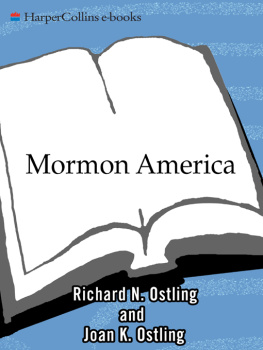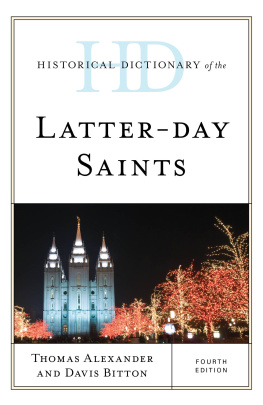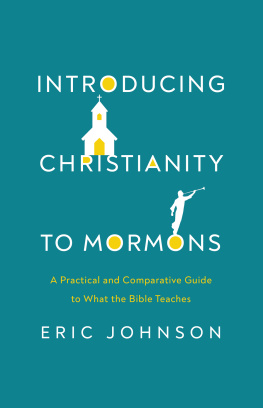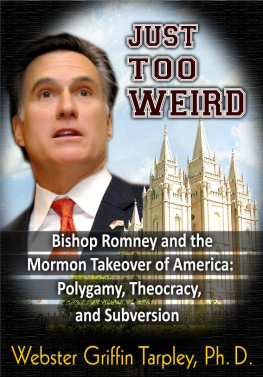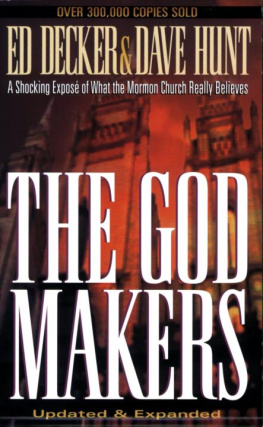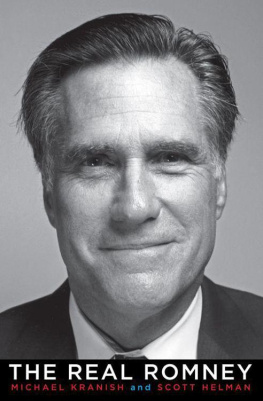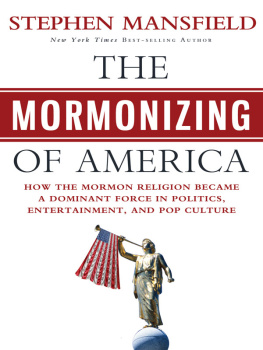Richard N. Ostling and Joan K. Ostling
S HOULD NON -M ORMONS WRITE A BOOK ABOUT M ORMONISM? T HE COAUTHORS are, admittedly, conventional Protestants. Sometimes it seems as though adherents of this faith would prefer to see depictions only by fellow believers. But we were encouraged in preparing the original 1999 edition of this book when a respected Brigham Young University scholar remarked that perhaps only outsiders could produce the sort of work we had in mindnamely, a candid but nonpolemical overview, written for non-Mormons and Mormons alike, focusing on what is distinctive and culturally significant about this growing American movement. If we have succeeded, the outsiders will find some fascinating information and want to learn more, and the insiders will see themselves portrayed fairly while learning some things they would not have known otherwise.
This book originated when Richard N. Ostling and S. C. (Sam) Gwynne were fellow Time magazine correspondents who did the field reporting for the 1997 Mormons, Inc. cover story. Ostling covered the spiritual side and Gwynne the temporal aspects and fabled wealth of the Church of Jesus Christ of Latter-day Saints. Though that reportage was the starting point, almost all the material was newly developed during preparation of the book as coauthored by Richard and his wife, Joan K. Ostling. This 2007 edition incorporates much new material since 1999 but retains the basic interviewing and the financial research (Chapter 7) in the original edition.
Ostling, now a freelance writer, was Time s longtime religion writer as well as a staff correspondent, and later covered religion for The Associated Press. During decades as a specialist in the field he has frequently treated the LDS Church, including in-person interviews in Salt Lake City with church presidents Spencer W. Kimball (1978) and Gordon B. Hinckley (1997). Gwynne brought special credentials to exploring the money side, perhaps the most controversial topic in the magazine article and this book. An international banker turned journalist, he has been editor-in-chief of California Business magazine and the senior editor managing Time s business section. His work as a Time correspondent, including coauthorship of the book The Outlaw Bank (1993), won him the John Hancock and Gerald Loeb awards for financial writing and the Jack Anderson Award for investigative reporting (the latter named in honor of the most famous Mormon in journalism). He is now an executive editor of Texas Monthly. The coauthors gratefully acknowledge his contributions on the subject of church finances.
On terminology: Normally it is good journalistic practice to call people what they prefer to call themselves. Not all conservative Protestants want to be labeled Fundamentalists, for example. In recent times the church informed media personnel that the Mormon nickname for members is incorrect and confusing and that the word should appear only in the scriptural name, the Book of Mormon. This was an attempt to make water run uphill because the term is deeply ingrained in ordinary usage. Mormon and the useful LDS shorthand carry no particular animus, and both are commonly used by members unashamed of their affiliation. To the general public, the faiths best-known ornament, after all, is the Mormon Tabernacle Choir, and the churchs own Web site (www.mormon.org) to educate non-members.
An edict from the First Presidency prior to the 2002 Winter Olympics in Salt Lake City softened things, stating that Latter-day Saints is preferred in references to adherents but Mormons is acceptable. Members of the media are beseeched to state the churchs full official name when possible and use the Church of Jesus Christ (a suggestion that would confuse readers) or the Church on second reference, while avoiding Mormon Church or LDS Church. To describe the general culture, Mormonism is deemed acceptable. (The church especially abhors the frequent use of the Mormon Fundamentalist self-designation by breakaways, saying they should simply be called polygamous sects or groups.)
This books practice is to use the churchs full name here or there, Saints occasionally (and always with a capital S since other churches employ this term generically), and Mormon or LDS much more frequently.
Mormon was long useful in distinguishing the Utah-based church from the smaller, Missouri-based Reorganized Church of Jesus Christ of Latter Day Saints (capital D and no hyphen, the sort of detail that keeps copy editors alert). But in 2000 a Reorganized Church conference adopted a fuzzier official name, Community of Christ, to underscore a separate identity from the better-known Saints church. This book uses Reorganized or the RLDS abbreviation for events prior to the change, and the current name where appropriate.
The LDS scriptures are listed by full name (the Book of Mormon, Doctrine and Covenants, Pearl of Great Price [and subsections of the latter: the Book of Moses, the Book of Abraham, Joseph SmithHistory, and the Articles of Faith]). LDS scripture citations are named in full (since the titles are unfamiliar to general readers) except for the Doctrine and Covenants, abbreviated as D&C. Another frequently used abbreviation is BYU for Brigham Young University.
Two distinguished scholars, both LDS Church members in good standing, vetted the 1999 manuscript prior to publication. We appreciate their corrections and suggestions. We also express our warm personal thanks to the Mormons who shared their faith journeys with us; the anonymous sources who provided financial information and copies of the 1988 and 1999 General Handbook of Instructions, with its essential information not available to the churchs membership or the general public; the LDS officials and scholars who granted interviews and have provided a rich range of written materials; and the church Public Affairs Department, which patiently fielded queries. As prefaces always state, the sins of omission and commission herein are ours, not theirs. We are also grateful for old-fashioned public and academic libraries and bookstores, and for modern interlibrary loans, toll-free phone and online book orders, faxes, CD-ROMs, e-mail, and (with reservations) the World Wide Web.
Those readers who are immersed in this complex field will immediately recognize how much this book draws upon the prior expertise of specialists in the LDS community, who have produced a truly remarkable array of works. We freely acknowledge that indebtedness. Rather than footnotes within the text, there are notes at the end of the book listing important source references for each chapter. Many significant contributions are credited in the text as well as in our suggestions for further reading.

